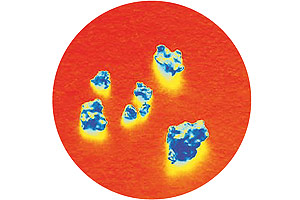Stomach and intestinal disorders
– Hernia: when an organ peeks out of the normal limits of the cavity that contains it, it is dubbed hernia. Although there are hernias at different parts of our body, the abdominal cavity is where we find some of the most common ones. Generally, the name they receive is according to their place of appearance.The hiatal hernia corresponds to the displacement of the superior part of the stomach towards the thorax through a weakness of the diaphragm muscles. Usually, it affects overweight people. Also standing out among the most common is the umbilical hernia, in which part of the intestine peeks out of the navel. – Stomach cancer: if some kind of cell that makes up the layers of the stomach multiplies in an uncontrolled manner, it can cause this serious disease. Gastric cancer mostly affects people over 50 and is not detected in time many times because its symptoms (stomach discomfort, gas, appetite disorders) tend to be confused with other stomach afflictions.
– Gastritis: it is the inflammation of the coating of the stomach, generally caused by the consumption of irritating foods, alcohol, medication or by a stomach infection. Generally, the gastric mucosa seems red and altered. It is characterized by persistent stomach discomfort, nausea, vomiting, indigestion, loss of appetite and a continuous burning sensation in the stomach. It is a broad term because there are different kinds, like acute, chronic or erosive.
– Peptic ulcers: the stomach as well as the first portion of the small intestine can find themselves affected (in their diverse layers) by a continuous wear and tear that generates true rips within their walls. These are called peptic ulcers, caused by an unbalance between stomach acid and the coating walls. This disorder causes pain, loss of appetite, nausea and, in more complicated cases, internal hemorrhages and even total perforation of the aforementioned digestive tube walls. Among its causes we must point out a bad diet, abuse of toxic substances (like cigarettes and alcohol) and, lately, the action of the Helicobacter pylori bacteria in the appearance of these real stomach and intestinal wounds has been referred to. Depending on their location, it is possible to identify gastric ulcers (that affect the stomach) and duodenal ulcers (located in the small intestine).
– Intestinal polyps: they are true “masses” of tissue (some are mushroom-shaped) that protrude from the internal wall of the intestine, but can also be found in the stomach. Intestinal polyps are differentiated between pedicled and sessile, depending on the way they are set to the intestinal wall. The first, through a thin stem and the second with a wider base.
Most of these portions of tissue are benign and do not represent much of a problem for those who suffer them. However, it is important to control them because they can stem into some kind of cancer.
– Appendicitis: it is the inflammation of the appendix caused by obstruction due to fecal matter or another foreign element. Generally, the invading material piles up, gathers thousands of bacteria that infect the intestinal portion, inflame it and can cause its ulceration. Generally, this disorder is solved with the total extirpation of the appendix. If this is not done in time it can cause a general infection that can even affect the abdominal coating, affliction called peritonitis.
Hepatic, pancreatic and biliary afflictions
Next, we will refer to the most common disorders and pathologies that affects these attached digestive glands:
– Hepatitis: it is the inflammation of the liver, which can be caused by adverse reactions to some medication, poisoning due to toxic substances, bacterial infection or, more commonly, viral infection. In this last case, different varieties of virus can affect the body. Among the most well-known hepatitis A, B or C stand out. This disease is usually acute and short, but if the virus that caused it is powerful and if there are complications, a hepatic transplant may be necessary.
– Hepatic abscess: it is the accumulation of puss within the liver due to an infection caused by bacteria or amoebae, which spread to other areas of the body. Among its symptoms we point out fever, nausea, loss of appetite, increase in liver size and pectoral pain. Hepatic abscesses caused by amoebae is common in tropical countries and wherever there is scarce hygiene. In these cases, the most evident symptom is diarrhea.
– Cancer of the pancreas: among its symptoms we point out continuous superior abdominal pain that irradiates down to the back, besides loss of appetite, weight and icterus (yellow coloration of the skin and ocular membrane). Abnormal cells generally start to spread from the pancreatic head, around the ampulla of Vater. The tissue of the pancreas losses its normal organization and, seen in a microscope, presents groups of irregularly shaped malignant cells.
– Gall stones or choledocholithiasis: they are true stones that settle in the gall bladder as well as the biliary ducts. Most of these stones, made up of biliary pigment and cholesterol, are produced by an alteration in the chemical composition of bile.One of the most common complications occurs when the stones settle and obstruct the ducts bile flows through towards the duodenum; this irritates and inflames the gall bladder.








 Muere Evita
Muere Evita